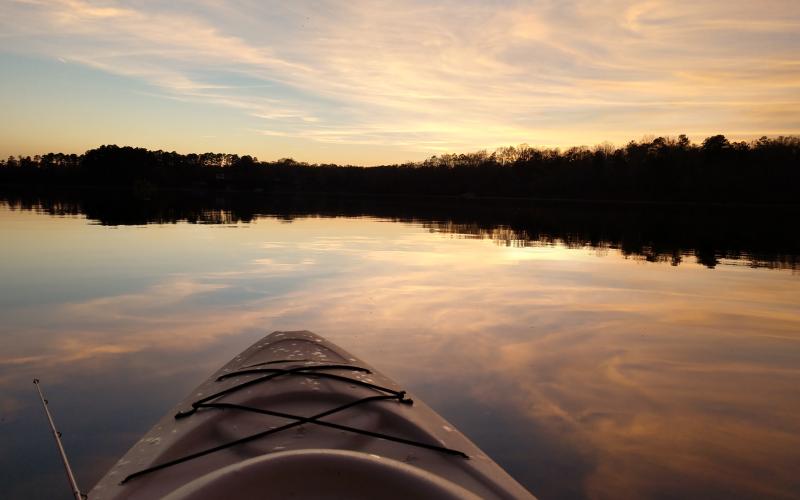Story from Lake Living Spring 2020
Kayaks are a 'simpler, quieter' way to scratch fishing itch
By Michael Hall
An angler without a boat is limited in his options. Sure, there is plenty of shoreline along Northeast Georgia’s lakes, but being off the bank and having the ability cast at it, instead of from it, can make all the difference.
As a reporter in Hartwell who moved here less than two years ago, I know that all too well. With more than 960 miles of shoreline and 56,000 acres of water, Lake Hartwell seems like a daunting task without some sort of vessel.
I was also well aware of how much money it takes buy a bass boat and the subsequent cost of ownership that comes along with it. My answer? A kayak.
It may not get you where you’re going as quickly, but kayak fishing presents several other unique opportunities that are only possible when you slow down, sit low on the water and paddle your way where the fish are biting.
Brian Sanford, a photographer and avid kayak angler, doesn’t need to be informed of the virtues of paddling; he has been at it for years. Sanford is a member of Georgia Kayak Fishing, a club dedicated to exactly what it sounds like — kayak fishing Georgia.
After growing up around Lake Lanier and working with boats at marinas, Sanford said he realized the simpler, quieter way to scratch his fishing itch was with a manpowered vessel.
“One thing about kayak fishing is it’s really simple,” Sanford said. “You just throw your kayak in the back of the truck or your SUV and go to the water. All you need is a life jacket, a paddle, a fishing pole and a kayak and you can go. There’s no maintenance. There’s no real cost of ownership. You just throw and go, as we call it. Throw your stuff in the car and go.”
It is that simplicity that Sanford said has allowed him to fish pretty much every lake, river and coastal waterway in the state, all without the temperamental nature and increased costs of towing a bass boat wherever he goes.
Some of Northeast Georgia’s best lakes — Hartwell, Burton, Russell, Rabun and Nottely — all offer terrific kayak fishing opportunities, Sanford said.
Sanford’s rig is decidedly more advanced than the mine. Sanford’s has a stadium-style seat which positions the angler a little higher above the water than a traditional kayak seat and is infinitely more comfortable for a full day of fishing. His boat also is long, wide and stable enough to stand up in, making it a versatile fishing machine that also carries all of his gear and a cooler.
My kayak is considerably less luxurious. It is 10 feet long, the seat sits low inside of it like a traditional kayak and has two rod holders. It is essentially the most basic kayak there is, just with two rod holders.
The important thing is, though, it floats. So, when the weather warmed and the time changed in March, a social distancing fishing trip was in order. I dutifully marched down the hill to the shoreline of Lake Hartwell lugging my kayak, got in and went fishing after work one beautiful afternoon.
I was skunked. One or two bites, but no fish landed. It’s a part of fishing with which every angler is familiar. I was just happy to, as Sanford put it, “get off the bank.”
“Kayak fishing is kind of the bridge between” having a full-sized boat and being limited to the shoreline. That’s why kayak fishing has ballooned in popularity in the past four to five years, Sanford said.
It used to be that people who liked to kayak would take a rod and reel with them.
“Now there are serious fishermen who are getting into kayaking,” Sanford said.
The type of kayaks available for fishermen has grown as well.
“The possibilities are pretty much endless,” Sanford said.
Beginner kayaks, like the one I paddle, are inexpensive and functional, but may not have some of the same creature comforts like the stadium-style seat. They start at around $400 to $500.
Pro-level kayaks equipped with everything from rudders and pedal-style paddling systems to trolling motors can reach up to as expensive as $5,000 in some cases.
Sanford suggests first setting a reasonable budget for the type of fishing you plan to do and finding the kayak to match it. Many kayak anglers like the boats that are between 12- and 14-feet long and that are 34-inches or more wide so they are stable enough to stand in while fishing, he said.
“It’s just so much more comfortable to sit in a stadium-style seat and paddle around and fish all day,” Sanford said. “If you decide it’s something you’re really into, then go spend $1,000, $1,500 on a fully outfitted fishing kayak.”
Once you have it, he said, you’re ready to get into some places bigger boats can’t go and search for the less-pressured fish — remote and shallow coves on Lake Hartwell, smaller lakes like Burton, Rabun or Seed, or the rivers that flow in-between them. It’s all part of the adventure of fishing from a kayak, Sanford said.
“That’s the great thing about kayak fishing,” he said. “if you have a pond in your neighborhood, go throw it in in the pond. If you want to go to Burton, go to Burton. It’s also fun for the adventure part of it.”
For me, a lack of any fish on the stringer after three hours of fishing was discouraging, but when the sun sank low on the horizon, painted the sky with the clouds and reflected onto the glass-like lake, it was well worth the effort.

